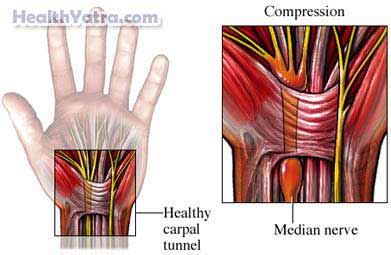সংজ্ঞা
Carpal tunnel syndrome is a nerve disorder of the hand. It is caused by compression of the median nerve. The median nerve gets squeezed inside a narrow passage in the wrist called the carpal tunnel. This nerve provides feeling to the thumb, index and middle fingers, and half the ring finger.

কারণসমূহ
কার্পাল টানেল সিন্ড্রোম is created by pressure on the median nerve. This pressure is caused by the carpal tunnel becoming narrower. The narrowing can be caused by many factors, including:
- Swelling of tissue in the carpal tunnel due to injury or fluid changes in your body
- Hereditary narrow carpal tunnel
- Tumors (rare)
ঝুঁকির কারণ
একটি ঝুঁকির কারণ এমন কিছু যা আপনার রোগ বা অবস্থা হওয়ার সম্ভাবনা বাড়িয়ে দেয়।
Risk factors for কার্পাল টানেল সিন্ড্রোম অন্তর্ভুক্ত:
- লিঙ্গ: মহিলা
- অগ্রসর বয়স
- স্থূলতা
- Excessive alcohol consumption
- ধূমপান
- Activities with repetitive hand motions:
- Certain sports
- সেলাই
- বাদ্যযন্ত্র বাজানো
- Typing
- Assembly tasks
- Water retention from:
- হার্ট ফেইলিউর
- কিডনির সমস্যা
- Wrist injury:
- পোড়া
- Broken bones
- Compression or crush injuries
- আর্থ্রাইটিস
- ডায়াবেটিস
- Raynaud’s disease and phenomenon, which impairs blood flow in the hands
- Hormone-related conditions:
- গর্ভাবস্থা
- বুকের দুধ খাওয়ানো
- মেনোপজ
- হাইপোথাইরয়েডিজম
- Cushing’s disease
- Excess growth hormone
- Medicines:
- জন্ম নিয়ন্ত্রণ বড়ি
- Cortisone pills or shots
- Some high blood pressure medicines
লক্ষণ
Carpal tunnel syndrome causes symptoms in one or both hands or wrists. Symptoms may include:
- Tingling, burning, or numbness, especially in your thumb and index or middle fingers
- Pain or numbness that worsens with:
- Wrist, hand, or finger movement
- Sleep (symptoms may wake you)
- Hand stiffness or cramping that gets better after:
- Shaking your hand
- Waking up in the morning
- Weakness or clumsiness of your hand:
- Loss of grip strength
- Difficulty making a fist
- Frequently dropping things
- Pain that moves up your arm
রোগ নির্ণয়
The doctor will ask about your symptoms and medical history. A physical exam of your arms, wrists, and hands will be done. The exam will include tests of strength, sensation, and signs of nerve irritation or damage.
অন্যান্য পরীক্ষা অন্তর্ভুক্ত হতে পারে:
- Electrodiagnostic exam—Measures and records the speed of electrical conduction in your median nerve (to see if the nerve impulse in the hand is delayed)
- MRI scan—A test that uses magnetic waves to make pictures of structures inside your body, in this case the neck (cervical spine)
- X-ray—A test that uses radiation to take a picture of structures inside your body, especially bones
- Ultrasound—A test that uses sound waves to measure the width of your median nerve (may be used as a screening test or to guide injections)
চিকিৎসা
It is important to correct whatever is causing the carpal tunnel syndrome. Sometimes making simple changes in your workplace or home may help relieve symptoms.
চিকিত্সা এছাড়াও অন্তর্ভুক্ত হতে পারে:
Rest, Ice, Elevation, and Exercises
- Rest your wrist by keeping it straight and decreasing activities that worsen pain.
- Gently apply ice packs to the area.
- Elevate the hand above your heart to reduce swelling.
- Do exercises as directed by your healthcare provider.
A Wrist Splint
A splint will prevent extreme movements of the wrist. It is most effective when worn at night. It can help you avoid waking up with symptoms.
ওষুধ
- Pain relievers, for example, aspirin and ibuprofen
- Injection of cortisone into the carpal tunnel
সার্জারি
Surgery may be needed if symptoms are severe, or continue after you try other treatments. The most common procedure is the carpal tunnel release.
If you are diagnosed with carpal tunnel syndrome, follow your doctor’s instructions.
প্রতিরোধ
You may reduce your chances of getting carpal tunnel syndrome by taking these steps:
- Minimize repetitive hand movements when possible.
- Alternate between activities or tasks to reduce the strain on your body.
- When using your wrists, keep them straight. Let your arms and shoulders share the stress.
- Use your whole hand or both hands to pick up an item.
- Avoid holding an object the same way for a long time.
- If you work in an office, adjust your desk, chair, and keyboard so you are in the best possible position:
- Back straight
- Feet flat on the floor or resting on a footrest
- Knees level with or slightly lower than your hips
- Shoulders in a neutral position, not forward or back
- Elbows bent at a 90-degree angle
- Forearms parallel to the floor and wrists straight
- Take breaks at least every hour to:
- Rest or shake your hands
- Massage your palms and backs of your hands
- Get regular aerobic exercise such as walking or swimming.
- Cut down on caffeine and smoking. These activities may reduce blood flow to your hands.
